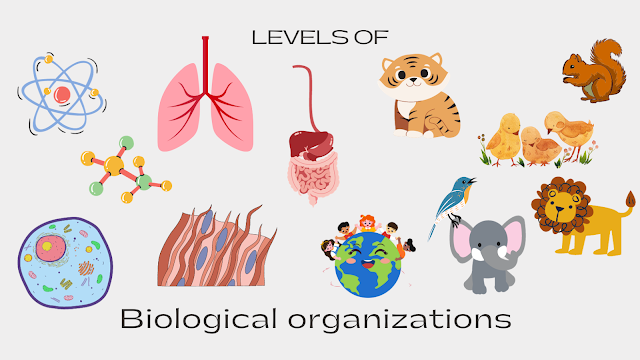Exploring the Levels of Biological Organization: From Cells to Ecosystems:
Biological organization is a fundamental concept in the field of biology that helps us understand how life on Earth is structured and functions. This hierarchy of organization spans from the smallest, most basic units of life to the largest and most complex ecosystems. In this article, we will delve into the levels of biological organization, from cells to ecosystems, to gain a comprehensive understanding of the intricate web of life.
Level 1: Atoms and Molecules
The foundation of all biological systems is built upon atoms
and molecules. Atoms are the smallest units of matter, and they combine to form
molecules. In the biological context, molecules like DNA, proteins, and
carbohydrates are crucial for the functioning of living organisms. These
molecules interact and give rise to the chemical processes necessary for life.
Level 2: Cells
Cells are the fundamental structural and functional units of life.
They come in various shapes and sizes, but all cells share common features.
Cells can be prokaryotic, lacking a nucleus, or eukaryotic, with a defined
nucleus. Within cells, organelles such as the mitochondria and chloroplasts
carry out specific functions, further illustrating the complexity even at this
foundational level.
Level 3: Tissues
Cells with similar functions and structures come together to
form tissues. There are four primary types of tissues in multicellular
organisms: epithelial, connective, muscle, and nervous tissues. These tissues
work together to carry out specific functions within an organism.
Level 4: Organs
Organs are composed of various tissues working in concert to
perform specific functions. For example, the heart is an organ comprised of
muscle tissue, connective tissue, and nervous tissue, all working together to
pump blood throughout the body.
Level 5: Organ Systems
Multiple organs collaborate to form organ systems. In the
human body, there are several organ systems, including the circulatory,
respiratory, digestive, and nervous systems. Each system serves a distinct purpose
while contributing to the overall well-being of the organism.
Level 6: Organisms
At this level, we encounter individual organisms, which can
be unicellular or multicellular. An organism can be as simple as a
single-celled bacterium or as complex as a human being. All organisms share the
common goal of maintaining homeostasis and reproducing.
Level 7: Populations
Populations consist of multiple individuals of the same
species living in the same geographical area. Understanding population
dynamics, such as growth and decline, is crucial in ecology and conservation
biology.
Level 8: Communities
Communities are made up of multiple populations of different
species living in the same area. Interactions between these populations, such
as competition for resources and predator-prey relationships, shape the
dynamics of communities.
Level 9: Ecosystems
Ecosystems encompass both the living organisms and their
physical environment within a specific area. This level of organization
includes the interactions between biotic (living) and abiotic (non-living)
components. Energy flow and nutrient cycling are key processes that sustain
ecosystems.
Level 10: Biomes and Biosphere
Biomes are large geographical regions characterized by specific climate and vegetation patterns. The biosphere encompasses the entire Earth, where all living organisms exist. It is the highest level of biological organization, connecting all ecosystems on our planet.
Understanding these levels of biological organization is
essential for biologists, ecologists, and anyone interested in the natural
world. It provides a framework for exploring and comprehending life's
complexity, from the tiniest molecules to the vastness of Earth's ecosystems.
By studying these levels, scientists can gain insights into how life functions,
adapts, and evolves, ultimately contributing to our broader understanding of the
natural world.








If you have any doubt, let me know.